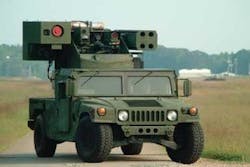LASER DEFENSE: Boeing conducts successful Avenger mounted-laser tests

The Boeing Company (Huntsville, AL) demonstrated this fall that its Avenger mounted-laser system can destroy improvised explosive devices (IEDs) and unexploded ordnance (UXO) like those that threaten U.S. troops deployed in war zones. During laser firings Sept. 26-27 at Redstone Arsenal in Huntsville, Laser Avenger used a 1 kW solid-state laser to destroy five targets and two small unmanned and stationary aerial vehicles (see figure).
For the test, the laser replaced a missile launcher on the Avenger air-defense vehicle, which usually fires Stinger missiles at low-flying aircraft. The original system, designed in the 1980s, is an inexpensive, lightweight, shoot-on-the-move ground-to-air defense system using Stinger missiles and a machine gun to provide defense and cover from helicopters, cruise missiles, air-breathing targets, and unmanned aerial vehicles. The laser part of the system can replace one of the two missile launchers on any Avenger base, whether it’s mounted on a High Mobility Multipurpose Wheeled Vehicle (Humvee)-its most common carrier-another military vehicle, or in stand-alone mode.
The laser used in the system is an off-the-shelf ytterbium-doped fiber laser from IPG Photonics (Oxford, MA). Blasting an infrared beam at a wavelength of 1080 nm, the laser has a range from 100 m to 1 km, says Linda James, communications manager at Boeing Missile Defense Systems. Current tactics to detonate IEDs and UXO involve robots or mechanical arms, which are sometimes destroyed in the process. The range of the Laser Avenger, being remotely operable at a “safe” distance from the target, would prevent destruction of or damage to the old-style short-range detonator systems.
Although the laser vehicle was stationary during the tests at Redstone Arsenal, upgrades to shoot-on-the-move capability seem the next logical step. “When one of the Stinger missile pods is replaced with the laser,” says James, “the system is capable of engaging ground-to-ground targets. Future funding could enable development of target-tracking technology needed to enable air-to-air capability.”
Avenger was developed using several off-the-shelf components already in the Army’s inventory. Since 1999, when the Army approved full-scale production of the Avenger, more than a thousand Avenger units have been delivered to the U.S. Army, U.S. Marine Corps, Army National Guard, and international customers worldwide. With this widespread, pre-existing technology base already deployed, the Laser Avenger is “ready to be fielded,” according to Boeing.
About the Author
Valerie Coffey-Rosich
Contributing Editor
Valerie Coffey-Rosich is a freelance science and technology writer and editor and a contributing editor for Laser Focus World; she previously served as an Associate Technical Editor (2000-2003) and a Senior Technical Editor (2007-2008) for Laser Focus World.
Valerie holds a BS in physics from the University of Nevada, Reno, and an MA in astronomy from Boston University. She specializes in editing and writing about optics, photonics, astronomy, and physics in academic, reference, and business-to-business publications. In addition to Laser Focus World, her work has appeared online and in print for clients such as the American Institute of Physics, American Heritage Dictionary, BioPhotonics, Encyclopedia Britannica, EuroPhotonics, the Optical Society of America, Photonics Focus, Photonics Spectra, Sky & Telescope, and many others. She is based in Palm Springs, California.
